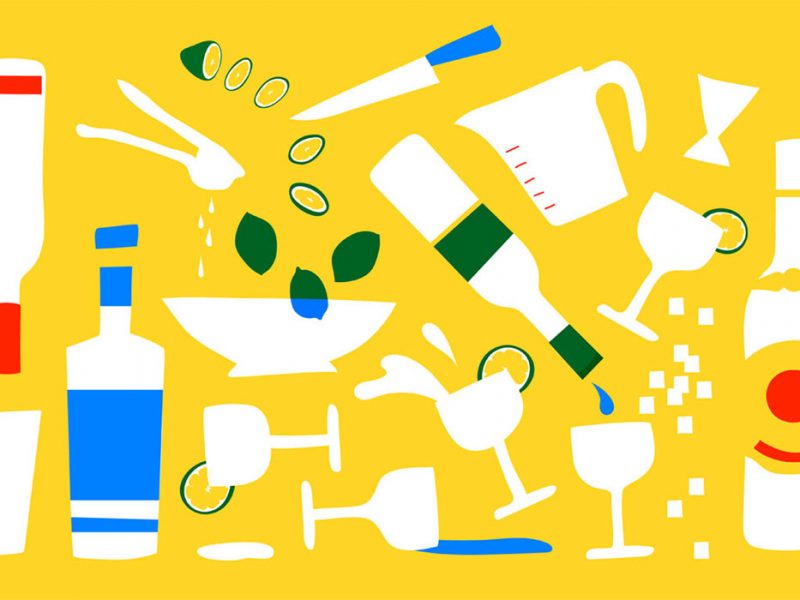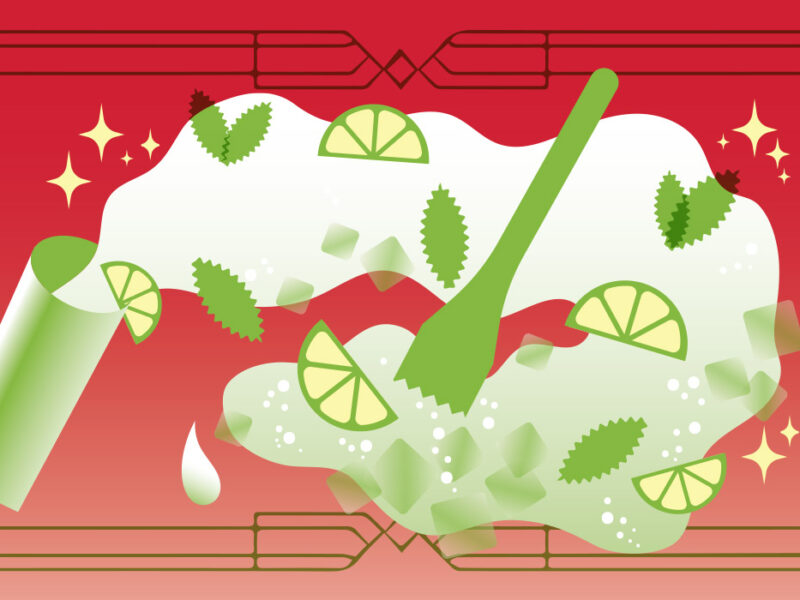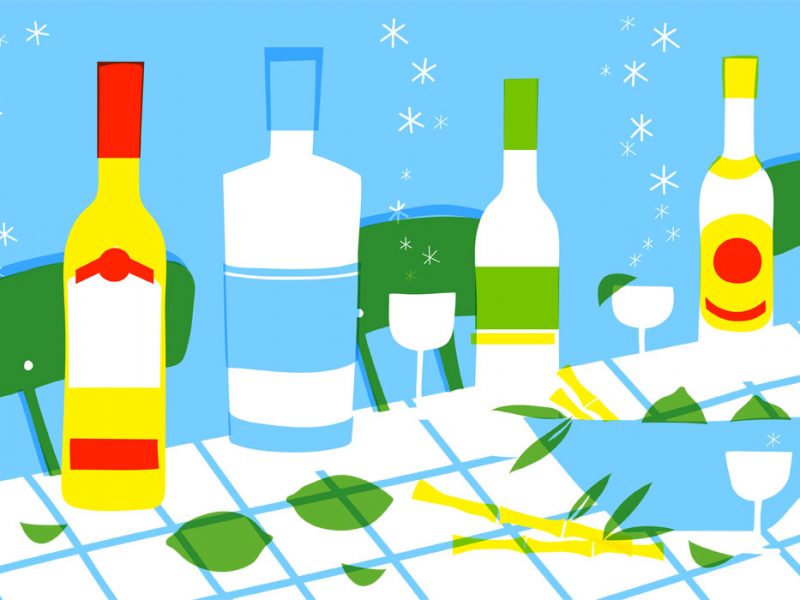As the Daiquiri is the preeminent rum cocktail, we knew we had to investigate it for the inauguration of the Rum Reader. Accordingly, we invited a who’s who of New York bartenders and historians to meet us at that storied drinks headquarters, Death & Company, for a lively discussion of all things Daiquiri.
However, Audrey Saunders, a crucial member of our panel, was not able to be present at the event. After conferring with her by email, we realized that her comments were so illuminating that they needed to be published immediately. So tune in next time for the results of our fascinating panel discussion, because this week, it’s all Audrey. (Thanks to Troy Sidle, the moderator of the forthcoming discussion, for the questions to Audrey that spurred this piece.)
For those of you who have been living beneath a sports bar for the last couple of decades, let’s drag you up to date. Audrey Saunders’ bartending career took an early turn when she attended a course taught by King Cocktail himself, Dale DeGroff. Like many who cross his path, she then knew she would dedicate her life to exploring and reinvigorating classic bartending. In short order she was part of Dale’s opening team at the ahead-of-its-time Blackbird in 1999. Stints running the bar programs at the Beacon, the Tonic, and the Carlyle Hotel’s Bemelmans Bar culminated in 2005 with the opening of her masterpiece, Pegu Club. A whole generation of world-class bartenders were trained at Pegu, and it’s still happening today.
What follows is a measure of brass tacks wisdom on the art of mixing drinks from one of the art’s foremost practitioners, in which light is shone on several competing Daiquiri specs found in the cocktail world today, including the mysterious origins of the now-ubiquitous sour format, “two, three quarter, three quarter.” — Ed.
A well-made Daiquiri is one of life’s little delights. For all its loveliness, though, it is quite a fragile, naked drink, which requires a deft understanding in order to prepare properly. There are no ingredients to hide behind, and everything to potentially lose through poor execution.
While it appears simple to prepare, it requires every understanding, mixologically: the choice of ingredients, method of preparation, type of mechanical action, degree of dilution, choice of glassware. Much like the practical portion of a final exam, the end result will always display a bartender’s skill set, whether good or bad.
The Daiquiri has evolved quite a bit over my career. Clearly there is more focus now on brand selection, product quality, and craftsmanship. At the beginning of my career, not even one aspect of that existed. The cupboards were totally bare, and the landscape was, for the most part, a wasteland.
Seemingly Simple
Pegu’s Daiquiri recipe has not changed since we opened. The recipe is:
2 ounces rum
.75 ounce lime juice
.75 ounce simple syrup (1:1)
You’re thinking, “easy,” right? Nope.
You need to take into consideration the flavor profile of the rum. And the lime. And the sugar.
Are you using straight sugar, or syrup, or gomme? The flavor of the common brand of beet sugar available in a big box store or deli is very high-pitched—stripped, without any real flavor. It works like icing.
The bag of organic cane sugar from the specialty food store will have a richer, lower-pitched flavor—it’s not as bright or as refined as white beet sugar, and that distinctive cane flavor resonates much more deeply on the palate.
Whether you’ve got a rum which has had its flavor profile stripped out through distillation or whether you’re going with a beautiful, well-crafted rum, your sugar selection is going to have a major effect on the outcome. If I’m stuck with a shitty rum, the richer cane syrup will probably step on whatever little flavor there is in the bottling. But that well-crafted, artisanal rum will shine with it.
About our spec—if you know anything about me, you know my incessant need to calibrate a cocktail for however long it takes to bring it to perfect fruition. A hundred iterations would be a normal starting point. In the ’80s and ’90s, Dale DeGroff reverse-engineered the .75 / 1 / 1.5 ratio from Jerry Thomas, which was ideal for cocktails at that point in time. Most folks who visited Blackbird in ’99 had never experienced a simple gin or whiskey sour made from scratch. They were used to chemical-based sour mix, which was very sweet. We made our scratch sours a little on the sweet side in those early days to provide for an appropriate transition for their palates—I think going from chemical sour to .75 / .75 / 2 would have been a bit too sharp and intense.
From 1999 to 2005, I was experimenting with the ratios of sour-based drinks. Sasha Petraske had already found his sweet spot with his handcrafted ice and increased citrus for his sour recipes. But his sour-based ratio with additional citrus simply didn’t work without his ice.
So at this point we had Dale’s earlier, sweeter ratio, the version in Embury’s tome (which begged for drier cocktails), Sasha’s increased sour, and a desire to recalibrate many of the crisper classics. Also, the utilization of more old-school ingredients (such as amari and gin) led to tighter, drier drinks. The tinkering continued.
Yet while I trusted my own palate, I also knew that taste is subjective…and that it takes a village. I had these very same conversations and tested various ratios together with a few bartenders on Pegu’s opening team (Chad Solomon, Toby Maloney, and Sam Ross, all of whom were concurrently working for Sasha). Because of their work with Sasha, they all had excellent understanding of cocktail structure, and the ratio of .75 / .75 / 2 was born from those fruitful, collaborative sessions of our tasting together.
Yet, in all frankness, it’s not one size fits all. There are a number of sours that I find work well with .75 / 1 / 1.75. This is Dale’s original ratio, with the spirit ratio bumped up a quarter ounce. We often refer to the effect of simple syrup in a cocktail as “fat.” Sometimes the .75/ .75 / 2 is too dry for what we want to accomplish, and that extra bit of simple syrup acts as a filler in the middle of the cocktail. Also, 1.75 ounces of spirit allows for more flavor to come through, in the same manner that adding water to whisky does: Aromatic molecules are set free. In this example, we now have a more flavorful sour with more mouthfeel, but perhaps still a touch sweet due to the increased sugar. So we then add back the cocktail’s structure with bitters. The bitters both dry it down, and provide increased spine and structure. But that’s another story!
Once my young bartenders grasp the dynamics of building a drink, I give them a task that I call the Daiquiri Project. They have to create a drink based on Pegu’s core Daiquiri recipe plus two ingredients. It helps them learn flavor calibration, and it’s especially important for bartenders who are including too many ingredients during the creative process. This structure forces them to dial back, eliminating ingredients which either don’t bring anything to the table or are stifling the expression of other ingredients. It can take months and months to perfect, but once it’s there, this same learning process is the foundation for all recipe creation.
Ice and Shake
The shake is equally if not more important than the recipe itself. I always use the Daiquiri to gauge a new bartender’s skill set and level of understanding, and whenever I provide the above Daiquiri recipe to them, they immediately think, “Ah, this is simple!” Yet the reality is that it’s one of the most fragile, challenging drinks around. It’s a stark, naked drink that doesn’t lie, and if you don’t get it right, it’s blatant at the first sip.
If you shake it incorrectly, you’ll destroy it. If you shake it too long, you’ll destroy it. And exactly what type of ice are you using? Large, hand-cut pieces, Kold-Draft full cubes, or standard ice? What is the density of your ice?
Back in the day, Sasha and I conducted a number of Daiquiri experiments together, and it was fascinating to see how the difference in our respective recipes turned out depending on the ice. The Milk & Honey recipe was .75 ounce simple syrup / 1 ounce lime / 2 ounces rum—a full quarter ounce more lime juice. To read that recipe on paper, it sounds overly tart. But he was also utilizing large, hand-cut ice to shake with, and somehow the dynamic of that combination worked out to perfection. When we tried his recipe together at Pegu, using Kold-Draft, in no way did it work! I was utterly fascinated by that. His recipe was specifically calibrated for his ice.
The thing about that large, hand-cut chunk is its density—and the degree of coldness that it imparts into the drink while keeping the flavor profile tight. Because it’s so dense, the drink doesn’t over-dilute, which also protects it from a potentially overzealous shake in the hands of a young bartender. Since I use a Kold-Draft machine, I have to make adjustments to the shake to somehow both mimic that density and protect it during the shaking process. If a younger bartender is still shaking a drink like a battering ram, all that excess water from dilution is going to absolutely drown it, so we counteract that by packing the shaker to the brim with the Kold-Draft ice, which prevents the ice from “traveling.” We are attempting to create an internal iceberg, where the drink can wash over it gently, taking the water it needs, while maintaining its integrity. Nor do we shake it back and forth like a piston—we employ more of an oval movement to further discourage the ice from shattering.
I can’t tell you how many times I’ve watched a young bartender assemble a Daiquiri, either in their bar, or at some event—I observe the recipe, the prep, thinking, “Okay, so far, so good.” But then they start shaking….and my internal timer automatically goes off, and I simply cannot help but count. I’m counting…and counting…and then I’m cringing while quietly uttering to myself, “Stop…stop…STOP SHAKING!”
By then, that drink has just drowned in its own water. It’s a heartbreaking, private hell for me. I don’t even have to watch, I can just close my eyes and listen to the shake—and I know.
A Sense of Place
When I think of the Daiquiri, I think of how it has evolved, historically. Equally important is its “sense of place.” The Daiquiri served in a New York craft bar in 2018 will have its origins in the craft cocktail movement of the late 1990s: shaken and served up in a coupe, unless requested otherwise. It’s distinct from the Daiquiri being requested in Cuba (or any other Caribbean island for that matter), which will largely be a frozen one. Both make sense in relation to their respective locations, hence their sense of place. It’s hot and sultry in Cuba, and you’re on vacation—who wouldn’t enjoy something slushy and icy cold?
I’ve enjoyed lots of Daiquiri #3s in Cuba, shaken as well as frappé. Both good, yet quite different. As a born and bred New Yorker, I preferred the tightness of the flavor profile of the shaken one, yet the frappé was decidedly more fun—especially since both were crafted by the expert hands of El Floridita’s head bartender, Alejandro Bolivar, and I got to enjoy them while standing next to a full-size bronze of Ernest Hemingway. Thus bringing to life the Daiquiri’s historical factor, tying it altogether.




